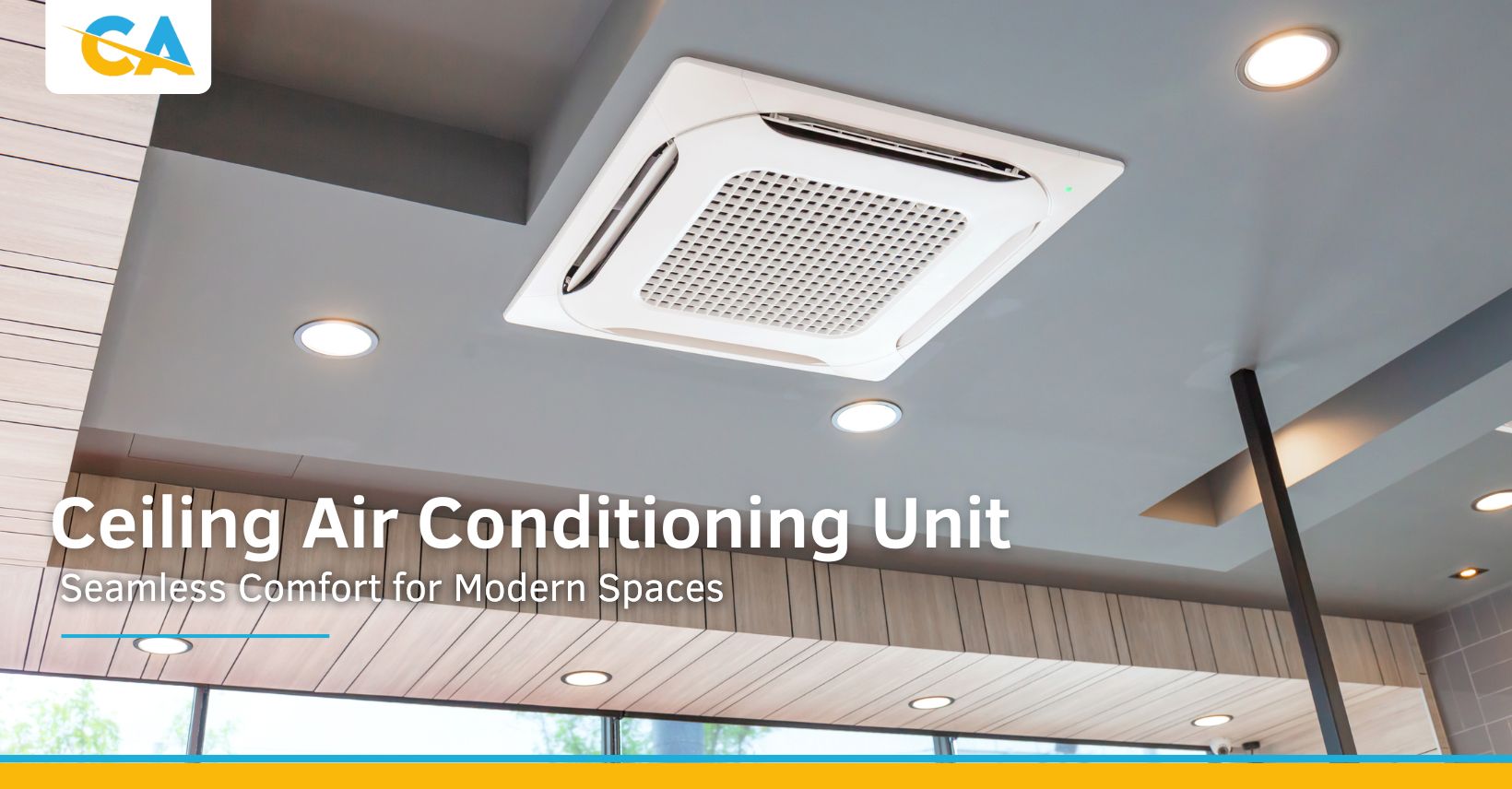Ceiling air conditioning units offer a seamless solution for modern spaces, providing optimal comfort and efficiency.
We explore these units, how they work, and their benefits, such as their space-saving design, improved air circulation, energy efficiency, reduced noise levels, and easy maintenance.
Discover the ideal spaces for these units, installation tips, and key features to consider when choosing a unit.
Find out how to maximise the use of ceiling air conditioning units with our comprehensive guide.
What Are Ceiling Air Conditioning Units?
Ceiling air conditioning units, also known as ceiling-mounted or cassette ACs, are popular in the UK for their efficient cooling and sleek design, which complements modern interiors.
Installed directly into the ceiling, these units save space and enhance the room’s aesthetics. One key benefit is their ability to provide uniform airflow, ensuring even temperature distribution.
They are widely used in commercial settings like offices, retail stores, and restaurants, maintaining comfort for customers and employees. Their quiet operation also makes them perfect for bedrooms or living rooms at home. This combination of features raises an interesting question about the mechanics behind their efficiency and quiet performance.
How Do Ceiling Air Conditioning Units Work?
Ceiling air conditioning units draw warm air, cool it through refrigeration, and evenly distribute the cooled air. The warm air passes through coils containing a refrigerant that absorbs heat, cooling the air.
This refrigeration cycle involves compressing the refrigerant, expanding it, and exchanging heat. A fan then pushes the cooled air back into the room through ducts and vents, maintaining a uniform temperature.
These units integrate with HVAC systems to optimise indoor climate conditions. This setup ensures a comfortable environment, making ceiling air conditioning units attractive for many spaces. Speaking of their appeal, there are several advantages to using these systems.
What Are the Benefits of Using Ceiling Air Conditioning Units?
Ceiling air conditioning units offer several benefits, including efficient cooling, precise temperature control, and quiet operation, making them ideal for residential and commercial settings.
Space-saving Design
The space-saving design of ceiling-mounted air conditioning units allows them to be installed flush with the ceiling, providing a sleek, discreet cooling solution.
These units seamlessly blend into a room’s overall decor, minimising visual clutter and creating a more spacious feel. They help optimise floor space by being positioned overhead, enabling furniture and other items to be arranged more freely.
This design choice not only offers a modern and streamlined look but also enhances the units’ functionality by efficiently distributing cool air throughout the room.
The hidden nature of ceiling-mounted air conditioning units makes them popular for residential and commercial spaces, where aesthetics and practicality are equally important.
Improved Air Circulation
Ceiling-mounted air conditioning units enhance airflow by distributing cool air evenly throughout the room, preventing hotspots and ensuring a comfortable environment.
This improved air circulation is achieved through the strategic placement of the units, allowing for consistent airflow from above rather than centralised in one specific area. By utilising the ceiling as the point of distribution, the cool air can disperse more effectively, reaching all room corners.
The benefits of this approach are manifold. It not only helps maintain a uniform temperature but also reduces the strain on the air conditioning system, leading to lower energy consumption and cost savings. Eliminating hotspots ensures that every part of the room receives adequate cooling, creating a more pleasant and comfortable indoor environment for occupants to enjoy.
Energy Efficiency
Ceiling air conditioning units are designed with energy efficiency in mind, often incorporating Inverter Technology to adjust cooling output and achieve noteworthy energy savings.
These mechanisms continuously adjust the compressor speed to match the cooling requirements, reducing energy consumption.
The use of high-efficiency filters and smart sensors helps optimise airflow and temperature distribution, further enhancing the system’s overall efficiency.
By minimising energy wastage and improving overall performance, ceiling air conditioning units not only reduce users’ electricity bills but also contribute to a greener environment by lowering carbon emissions.
Reduced Noise Levels
One of the standout features of ceiling air conditioning units is their quiet operation. Advanced technology minimises noise levels for a peaceful indoor environment.
By being mounted closer to the ceiling, these units direct airflow efficiently without causing disturbances. The strategic positioning also helps distribute the cooled air evenly across the room, ensuring consistent comfort.
Users can enjoy a calm and tranquil atmosphere without the constant background noise typical of traditional air conditioners. This feature is particularly beneficial in bedrooms, offices, and other spaces where noise reduction is highly valued. The reduced noise levels increase focus, productivity, and overall well-being.
Easy Maintenance
Ceiling air conditioning units simplify regular service with easy-to-access components, minimising downtime. Technical support is vital for optimal operation, assisting with troubleshooting, preventive maintenance, and addressing any issues.
Regular service ensures efficient performance, detecting and resolving potential problems early to extend the unit’s lifespan and enhance energy efficiency.
These features make ceiling air conditioning units an excellent choice, particularly in areas that require discreet and efficient climate control. Considering their versatility and efficiency, you’ll find them especially beneficial in various settings where space and design are important.
What Types of Spaces Are Ideal for Ceiling Air Conditioning Units?
Ceiling air conditioning units are versatile and can be installed in various spaces, providing effective cooling solutions for different environments.
Commercial Buildings
In commercial buildings, ceiling-mounted air conditioning units offer a discreet and efficient cooling solution that can handle large spaces and high foot traffic.
One of the key advantages of installing ceiling air conditioning units is their ability to maintain a consistent temperature throughout the facility without occupying valuable floor space. By being mounted on the ceiling, these units are not only out of sight but also help circulate the air effectively, ensuring a comfortable environment for occupants.
Installing ceiling air conditioning units allows for better distribution of cool air, leading to more efficient cooling of the entire space. This set-up minimises the chances of hot spots. It ensures a uniform temperature, improving overall comfort and productivity within the commercial building.
Residential Homes
For residential homes, ceiling-mounted air conditioning units provide a stylish and efficient cooling option that blends seamlessly with home decor.
The major advantage of incorporating ceiling air conditioning units in homes is that they free up valuable wall and floor space, allowing for a more streamlined and uncluttered interior design. Positioning the AC unit overhead also ensures cool air distribution, preventing hot spots and optimising overall cooling effectiveness.
Offices and Workplaces
In offices and workplaces, ceiling air conditioning units enable precise temperature control, ensuring a comfortable environment that can enhance productivity.
When employees work in a space where the temperature is too hot or cold, it can distract them from their tasks and reduce overall efficiency. With a well-maintained ceiling air conditioning system, the temperature can be regulated optimally, allowing employees to focus on their work without discomfort.
Ceiling air conditioning units are strategically placed to distribute air evenly throughout the office, ensuring all areas are kept at the desired temperature. This uniform cooling effect helps eliminate hot spots or chilly corners, creating a more pleasant and productive atmosphere for everyone.
Hotels and Resorts
Hotels and resorts favour ceiling air conditioning units because they are quiet and can maintain a comfortable atmosphere for guests.
One of the key advantages of ceiling air conditioning units in hospitality environments is their ability to distribute cool air evenly throughout the room, ensuring that guests experience consistent comfort regardless of their location.
In addition to maintaining a pleasant temperature, these units are also known for their noise reduction capabilities, which are essential in hospitality settings where a peaceful ambiance is paramount for guests.
The aesthetic appeal of ceiling units is another benefit, as they blend seamlessly into the room without taking up valuable floor space, allowing for a more spacious and uncluttered environment.
Retail Stores and Shopping Centres
Retail and shopping centres benefit from ceiling air conditioning units because they enhance airflow and maintain a pleasant shopping environment. Installing these units overhead efficiently cools the entire space.
It ensures well-distributed airflow, creating a comfortable and inviting atmosphere for customers and keeping the temperature consistent throughout the store.
It reduces humidity levels, preventing the sticky feeling often experienced in crowded areas. Typically quiet and unobtrusive, ceiling air conditioning units allow shoppers to enjoy their browsing experience without distraction. With these benefits in mind, understanding how to install ceiling air conditioning units is essential.
How to Install Ceiling Air Conditioning Units?
Installing ceiling air conditioning units involves several key steps, such as selecting the ideal location, ensuring proper electrical connections, and securing the unit with technical support from companies like Maximum Climate Control Ltd.
Choosing the right location is important for optimum airflow and cooling efficiency. Professional assistance can determine the best placement to achieve consistent temperature distribution.
The electrical connections for ceiling units require precision to avoid hazards, and technical support ensures a safe and efficient installation process. Securing the unit properly is vital for safety and longevity, with professional services like those from Maximum Climate Control Ltd. providing the necessary expertise for a seamless setup.
Considering these steps, it’s also important to consider various features when choosing a ceiling air conditioning unit.
What Are the Different Features to Consider When Choosing a Ceiling Air Conditioning Unit?
When selecting a ceiling air conditioning unit, it’s important to consider various features, such as cooling capacity, power rating, warranty, and additional functionalities, to ensure the unit meets your needs.
Cooling Capacity
The cooling capacity of a ceiling air conditioning unit, often determined by the model and power rating, is important for ensuring it can effectively cool the intended space.
The cooling capacity is the amount of heat an air conditioning unit can remove in one hour. It is measured in BTUs (British Thermal Units) or tons. To determine the appropriate capacity for your space, you need to consider factors like the size of the room, insulation, number of windows, and local climate.
A unit with a lower cooling capacity might suffice for smaller rooms, while larger spaces or areas with high heat loads would require a higher capacity unit for efficient cooling.
Airflow Direction Control
Airflow direction control is a key feature in ceiling air conditioning units. It allows users to adjust the direction of cool air to optimise comfort and distribution.
This feature enables individuals to direct the airflow upwards during winter, ensuring better circulation and even temperature distribution within the room.
Conversely, the airflow can be directed downwards in the summer to provide a refreshing breeze, maintaining a comfortable environment even on hot days. By controlling the airflow direction, users can prevent direct drafts and ensure that the cooled air is evenly dispersed throughout the space, avoiding any hot spots or uneven cooling.
Remote Control Options
Many modern ceiling air conditioning units have remote control options, which provide convenient access to adjust settings such as temperature, fan speed, and mode.
Having remote control capabilities eliminates the need for users to manually reach and adjust the settings on the air conditioning unit itself. This enhances user convenience and allows easy customization from a distance, making creating a comfortable environment without disruptions effortless.
The remote control options often come with intuitive interfaces, making it simple for users of all ages to operate and customising the settings to their preferences. This user-friendly feature adds a layer of accessibility and ease of use, ensuring a seamless experience when managing the indoor climate.
Energy Efficiency Ratings
Energy efficiency ratings are a critical factor to consider when choosing a ceiling air conditioning unit, as higher ratings typically indicate better energy savings and lower operational costs.
These ratings, displayed as SEER (Seasonal Energy Efficiency Ratio) or EER (Energy Efficiency Ratio), clearly measure how effectively the unit uses electricity to cool a space.
A higher SEER or EER means the unit consumes less power to deliver the same cooling capacity, resulting in decreased energy bills and reduced environmental impact.
Additionally, energy-efficient units often have advanced features like variable-speed motors and smart thermostats, allowing for precise temperature control and better comfort.
Investing in an energy-efficient ceiling air conditioning unit pays off lower energy costs. It contributes to sustainability efforts and overall environmental conservation.
Noise Levels
Ceiling air conditioning units require noise levels, and quieter models are preferred for maintaining a peaceful environment. Excessive noise can disrupt concentration in offices, affect sleep quality in homes, and reduce comfort in various settings.
Technological advancements have brought ultra-quiet ceiling air conditioning units featuring brushless DC motors and insulated compressor compartments to reduce noise. For the decision-maker selecting and maintaining these units, it is important to ensure the best performance.
Optimal Use of Ceiling Air Conditioning Units
To ensure the optimal use of ceiling air conditioning units, regular maintenance, effective feature utilisation, and understanding of the warranty terms to address any potential issues promptly are essential.
Regular maintenance involves cleaning or replacing air filters, checking for leaks, and ensuring proper airflow to maximise efficiency and extend the unit’s lifespan.
Effectively utilising programmable thermostats, energy-saving modes, and fan speed adjustments can bring noteworthy benefits. It can enhance comfort levels while also reducing energy consumption.
Understanding the warranty details, including coverage duration, service limitations, and required maintenance, is essential for swiftly resolving any technical problems or malfunctions that may arise.





